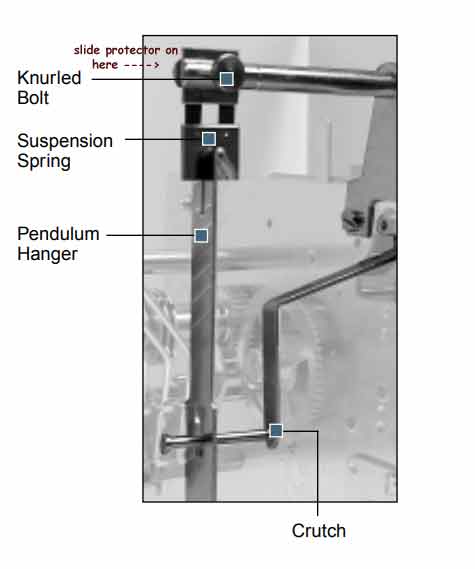How to Move Your Grandfather Clock
Posted on May 14, 2015 | By clockde | 15 responses
How to Pack my Grandfather Clock for Moving.
Follow these easy steps and you are on your way to moving your Grandfather clock.
Always start with the weights down about 3 – 4 days of the move.
You will need gloves, scissors, newspaper, painters tape, packing tape, a large blanket and about 40 minutes.
______________________________________________________________
1. Open the side access window (if any) and move them to a safe place where you may not step on one and break it.
2. If the clock has cable holding the weights, insert 3 – 2″ square Styrofoam blocks that came with the clock above each pulley between the cables. If you do not have a Styrofoam block, make a tight square of newspaper about 2″ inches in diameter and hold the block or newspaper square above the pulley as you wind the weights one at a time until they stop with the paper or Styrofoam block jammed above the pulleys. This procedure prevents the cable from tangling when the weights are removed. You need to keep tension on the cables.
3. For clocks with chains, raise the weights so the clock is about half wound (middle of the clock). Use a piece of thin wire or twist ties to string the chains together just where the chains protrude below the movement and tie the wire together; this action will secure the chains so they do not come off their sprockets. These need to be tight or the chain will come off the sprocket.
4. Remove the weights while wearing gloves and look at the bottom to see if they are marked “Left – Center – Right” . If not, mark them so they can be replaced to the same position on the clock for installation later. For clocks with chains, secure the chains by bunching them from bottom to top and wrapping them in newspaper and place a rubber band around the package so that they do not move around and possibly damage the finish. Package up the weights carefully as not to dent the brass casings.
5. Remove the pendulum by holding it from the middle and slightly moving it up. It should un-hook from the pendulum leader easily. DO NOT FORCE IT. The pendulum guide needs to be so that it may not move around during moving and it should never be under a lot of tension in any direction. You may take one or two full width pages of newspaper and gather the loose paper around the pendulum guide. Use just enough so it remains loose, but unable to freely move around.
6. Secure the pendulum leader: Place loose newspaper around the back of the movement where you took off the pendulum. You want the pendulum leader where you hang your pendulum unable to move around freely.
7. Secure the chime rods: The chime rods are those long thin rods that project downward inside the clock. Pull newspaper up puncturing the paper with the rods and sliding the paper up the rods. Do this a few times until the rods do not move around. This will probably take 5 – 6 sheets of newspaper.
8. Reinstall the access panels and lock them in or tape them from the inside (glass to wood) so the windows will not come out and break during moving. Close and lock the door(s).
9) Wrap the clock to protect the furniture. A queen size comforter should completely surround the clock. If not try any large blanket. Wrap the blanket around the clock and tape the blanket closed. Wrap the tape twice near the top of the clock all the way around, once near the middle and one near the base.
10. The clock can now be carefully moved to it’s new location. If the clock is a newer clock, you may move it on it’s back if you have followed the instructions above to the letter. Older clocks may need only to be moved in an upright position because of the weight of the movement and the way the movement may be fastened to the case.
How to pack your grandfather clock for moving:


very helpful instructions on moving a grandfather clock, thank you for your time.
Fantastic directions. Our local clock shop wouldn’t tell me how to do it but would move it for me to our new home 8 miles away. All for a fee of $455 plus tax. This is saving me a bundle.
Thank U thank U THANK U this is so awsome….
Now I feel so at ease to mak this move with my Ridgeway.
Did I say THANK U
Miss Bea
Great info
Very much appreciated.
Thanks
Thank you so much. My dad told me to “just take all the pieces off.” I was reluctant to follow his advice. This was very helpful.
Great! I hope it will be a successful move for your grandfather clock…Robert
Thank You so very much. We have professional movers, but they want us to prepare clock so this is awesome. I still have my styrofoam containers for my weights !!!
Moving my grandfather clock went fairly smoothly. After reading your instructions, setting the time/chimes was easy!
However, in fumbling around getting weights and pendulum off, a small black plastic piece fell from the general area of where the pendulum “connector” is located. It is running fine without it but I am worried about it none the less.
Any ideas on what the piece is for and where it goes?
BTW, the make of my clock is Sligh.
Best regards,
Philip
The small black piece you found is not needed for the clock to run well, it can easily be placed back on the clock. It protects the suspension spring. The is an open end to the piece you found and a solid end. The open end slides onto the horizontal post at the very top of the hanger from back to front. It is held on by friction. This keeps the suspension spring on your grandfather clock from twisting if one tries to move the clock with the pendulum still attached.
Excellent instructions. How does one determine the age where a grandfather is a “newer clock”, in which case it is permissible to lay a clock flat for transport? We will be moving a clock from Louisiana to Colorado and would prefer not to have to rent a box van if possible.
Hi Greg..We define newer grandfather clocks as those made in the last 25 or so years. It is alright to move a grandfather clock on it’s back as long as it has been packed properly. You also want to make sure the hanger where you unhooked your pendulum is not free to move around. If you loosely stuff some crinkled newspaper up in the back behind the movement in that area, it should keep the pendulum hanger from moving around. I move over a hundred a year on their backs.
Good Luck,
Robert
Thank you for the great information.
I will be moving or attempting to move a grandfather clock tomorrow 7/28/19 and you help I very appreciated .
Thank you Ken
Great! We hope your grandfather clock move went well.
Robert
We recently obtained a grandmother clock that was not packed per your instructions. Everything seems to be operating properly, however…. When we went to hang the pendulum, the hanger was not there, it was in the bottom of the clock. We are unsure of the proper way it should be as when we put it on based on what we saw, the pendulum swings, but does not continue to swing???
Great instructions! I have a Howard Miller with weights moved up by chains. Other than by waiting for the weights to lower over time, how can I safely lower the weights to begin the process of moving the clock?
Thank you,
William M.